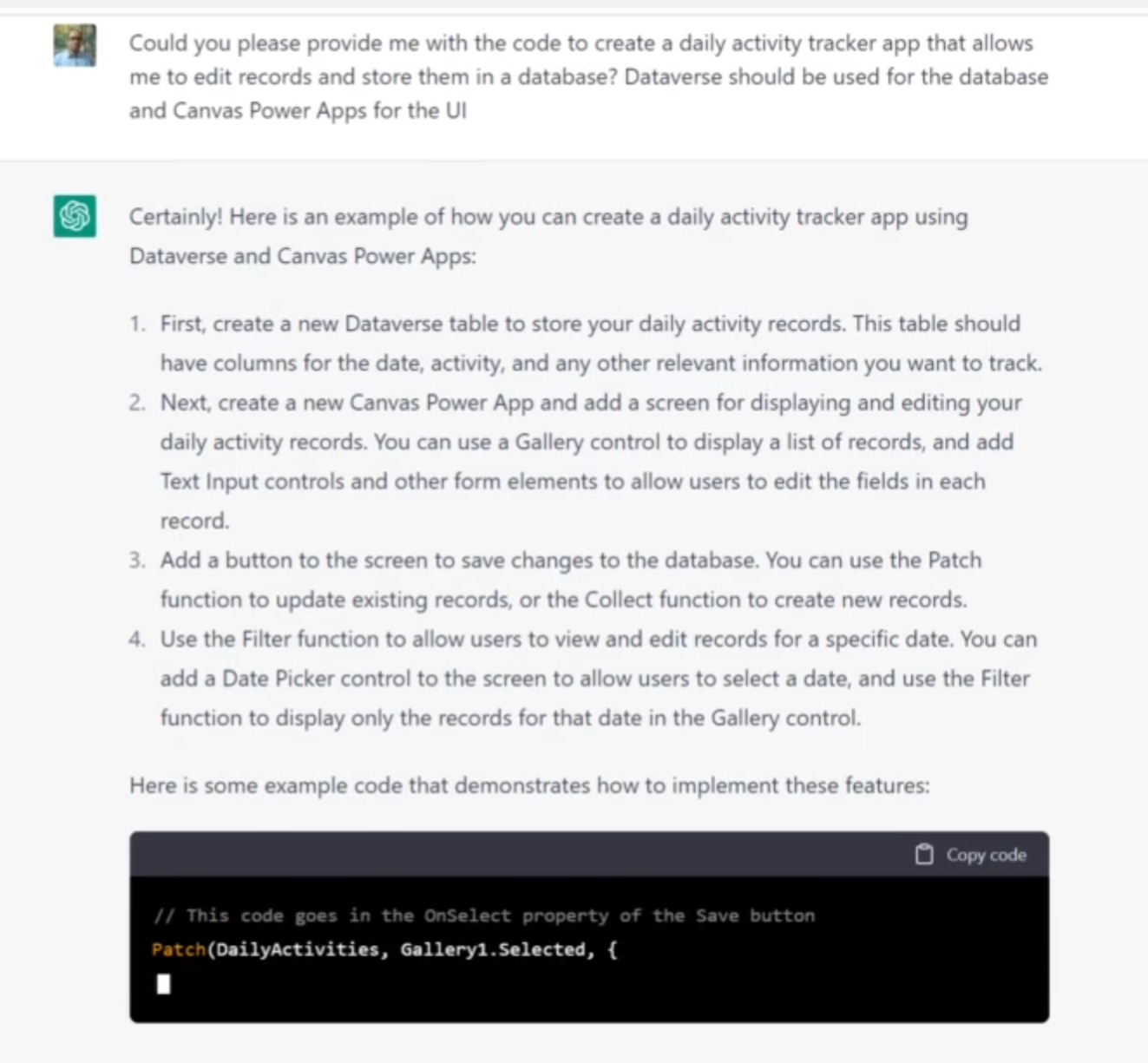Chat GPT was asked to build a Daily Tracker application in Canvas Power Apps — Does this mean we have a replacement?

In light of everyone's buzz over Open AI's ChatGPT, I reached out to OpenAI Chat to ask to build Daily tracker apps for Canvas PowerApps and use Dataverse as a back-end and the response was amazing.
If you remember, GitHub Co-pilot was released in October 2021, and the entire developer community loved it.
Others, like myself, thought that while the tool was interesting, it was so far from replacing humans. Certainly, it could improve a process, but it wasn't capable of creating apps from scratch.
Let's understand.
What is Open AI's ChatGPT?
By using the GPT-3.5 language model, the AI research group OpenAI has released a beta version of ChatGPT.
Basically, ChatGPT is a chatbot that answers questions based on artificial intelligence.
In order to produce text similar to that of a human, this chatbot uses deep learning.
How to use ChatGPT?
Launch the website https://chat.openai.com
If you are a member of OpenAI, log in to your account by clicking the "Log in" option.
Here's what happened.
Ask to Bot: Could you please provide me with the code to create a daily activity tracker app that allows me to edit items and store them in a database? Dataverse should be used for the database and Canvas Power Apps for the UI?
Since humans could easily understand this question, I purposely asked it in a complex & ambiguous form to ensure that AI keeps track of what's being discussed.
Please watch the full video: Daily Activity Tracker app in Canvas Power Apps

What do you think of this outcome?
My initial impression is that the results are excellent, I wasn't expecting such a detailed analysis.
But when it came to building the app, I found a couple of issues that highlight the weaknesses of this bot.
Problem #1: It is not understanding a list of fields. I know, we put lots of thought processes to design the wireframe and solution approach. but field datatypes and solution design principles were missing.
Problem #2: Code is not generated as per the best practices. I know, we apply common and enhanced best practices while writing code as well as consider optimization aspects.
I was impressed with the bot's knowledge of my query, and the code was, in fact, compatible with Canvas PowerApps, So I was able to get started right away.
It's awesome to play Chat GPT, no doubt about it. But there are some flaws with Chat GPT.
At the same time, it is fascinating to see how technology is helping humans to save time in day-to-day activities. so that humans can focus more on decision-making tasks.
But developers aren't being replaced.
Why? The reasons I outlined above are due to two problems. If you haven't noticed, the bot simply divides content from articles it has been trained on.
In other words, it's not creating code from scratch, which should be flawless, but displaying what other authors have written.
As things stand, Chat GPT will only be useful as long as the content it is trained on is verified and updated.
In what ways will it benefit the developer community?
In my view, this tool might come in handy to everyone in day-to-day work regularly.
In most cases, you land on Google when you enter an issue.
You can now ask a question directly on Chat GPT and it will most likely give you the best-ranked answer from some high-ranked article.
Should we thoughtlessly trust Chat GPT's code?
In my view, the straightforward answer is No because you still have to think.
However, it will provide you with a quick start. You'll be able to find answers to your questions much faster if you simplify your search process.
According to Chat GPT's algorithm, all it can do at this point is perform a faster Google search.
Conclusion
Developers can benefit greatly from this bot.
I hope this article was a good read for you. Do share it with your friends and other peers.
Thank you so much!
Thank you for Reading - Let's Connect!
Enjoy my blog? For more such awesome blog articles - follow, subscribe and let's connect on LinkedIn, Twitter, YouTube
Stay tuned!
Published on:
Learn moreRelated posts
Microsoft retires the Power Apps Per App Plan
Although not yet officially announced by Microsoft, the Power Apps Per App Plan has been retired, seemingly with immediate effect. What was th...
Power Apps Grid Container: A Better Way to Build Responsive Canvas Apps
Microsoft is always rolling out updates to improve the Dynamics and Power Apps experience. Recently, Microsoft introduced Grid Containers in P...
Building Standalone Apps with Power Apps Code Apps: Using Dataverse and Office 365 Users Connectors (Part 1)
In the Dynamics 365 and Power Apps ecosystem, we have several options for building applications, each one is for a specific type of requiremen...
Build AI-Powered Apps in Minutes with Power Apps Vibe: A Complete Guide
If you’ve ever tried building apps with Microsoft Power Apps, you know the process: creating tables, designing screens, adding controls, conne...
How to Vibe code yourself a Power App on vibe.powerapps.com
Recently Microsoft released a new way of developing apps within the Power Platform on vibe.powerapps.com. In this post, I will look at differe...
Power Apps Code App with Dataverse: Building CRUD Operations
In my previous blog post, I explained how to build a Code App using Power Platform Connectors. In that example, I used the Office 365 connecto...
Create MS Graph subscriptions in Power Apps without Power Automate
A while back I wrote a post about MS Graph subscriptions in Power Automate. Today I managed to do this directly within Power Apps.